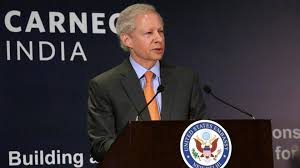
With China on mind, US envoy pitches for economic, military ties with India
Amidst shifting geopolitical equations in the Asia-Pacific region, US Ambassador to India Kenneth Juster has called for forging a robust strategic economic partnership with India and pitched for enhanced defence collaboration across the spectrum.In a defining speech on India-US relations, organised by Carnegie India and the US Embassy in New Delhi, Mr Juster projected the growing importance of India-US ties and the need to “build upon this foundation in a flexible but purposive manner”.The US ambassador’s big-picture presentation of India-US relations comes ahead of a likely meeting later this month between India’s Prime Minister Narendra Modi and US President Donald Trump on the sidelines of the World Economic Forum in the Swiss resort of Davos.
Economic ties through strategic lens
Proposing a Free Trade Agreement with India in future, the ambassador pointed out that India could be an alternative for US companies exiting China. He also assured that US President Trump’s call of “America first” and Indian Prime Minister Modi’s “Make in India” initiatives are not “incompatible” since mutually beneficial investment in each other’s markets increases the prospects of economic interaction and a robust trade leading to the technological collaboration and creation of jobs. While India-US trade has grown from $20 billion in 2001 to $115 billion in 2016, the trade deficit in favour of India stands at $30 billion and many US companies are unhappy with the protective barriers put in place by India.
“Increased heft in our economic relationship would necessarily provide a broader and deeper, long-term U.S. commitment to India and the Indo-Pacific region. This would complement our growing defence and counter-terrorism partnership, and moderate any policy differences that might arise along the way,” he said.

